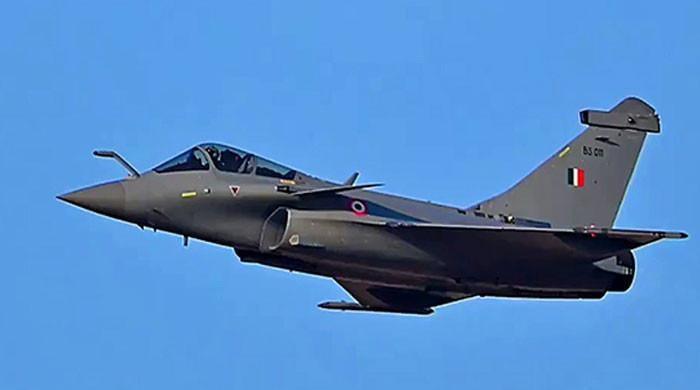- Rafale equipped with 200 km range came close to the border.
- Pakistan blocked IAF Jets’ on board sensors, communication, radar.
- PAF’s J-10C fighters equipped with 230 km range PL-15 missiles.
Since the Pahagam incident, India has tried to provoke Pakistan with its warmer and aggressive actions near the border, but Pakistan has shown restraint and has prevented India from aggression with timely defensive measures.
Due to effective defensive measures, Pakistan Air Force (PAF) was once again timely foiled India’s attempt to move on to Pakistan a few days ago, forcing India’s modern Rafale aircraft to retreat.
PAF prevented India’s progress night between April 29 and April 30. According to relevant sources, PAF took this action the same evening as the federal Minister of Information Attaullah Tarar expressed fear that India could attack Pakistan in the following 24 to 36 hours.
The sources said that four Indian Rafale aircraft started from Ambala Air Base in the Indian state of Haryana and moved towards Pakistan with a 1,200 -kilometer soil. The Indian aircraft came very close to the Pakistani airspace, but at no time did they cross it.
As these aircraft were equipped with modern Spice 2000 air-to-earth missiles, which have a range of 200 kilometers, this act of the Indian Air Force (IAF) was a hostile action because the Indian aircraft could have performed soil operations in Pakistan while staying in their own airspace.
These aircraft flyed at an altitude of 40,000 feet as Pakistan’s air defense system through its electronic warfare assets jammed Rafale aircraft on board sensors and communication and radar systems that these aircraft lost contact with each other and with the ground.
According to sources, J-10C aircraft were also in the air to confront the Indian aircraft and prevent any kind of aggression. Because of this situation, the Indian aircraft had to make an emergency landing in Srinagar instead of returning to Ambala.
It is relevant to mention here that the Rafale aircraft were equipped with missiles with a number of 200 km that night, but the J-10C aircraft in Pakistan Air Force were equipped with PL-15 missiles with Beyond Visual Range from 230 km. This means that the Pakistani aircraft was also able to target the Indian aircraft while remaining on their own territory.
Relevant sources say that if our air defense system had not jammed the communication and radar systems for Rafale aircraft that night, the Indian aircraft could have taken some actions on Pakistani territory.
Another interesting point to note is the fact that the Pakistani Air Force treated the four Rafale aircraft at night between April 29 and April 30, in the same way as blocked the radar and communication systems for Indian pilot Abhinandan in 2019.
According to relevant sources, after being subjected to failure at night between April 29 and April 30, IAF planned to intervene in Pakistan on Friday.
But as soon as the intelligence in this case was received, Pakistan immediately had 40 to 50 aircraft airborne, including F16, J-10C and JF-17. This action from Pakistan forced IAF to abandon its plan.
This means that India has again been subjected to a setback similar to 2019.
According to relevant sources, the multi-domain functions of the armed forces, especially PAF, play an important role in averting Indian ambitions. Relevant sources say that PAF is always one step ahead of India in electronic, cyber and space wars. And in the last four or five days, Pakistan fully utilized from these modern abilities and took proactive actions.
Pakistan has averted India’s most advanced Rafale aircraft. India had attached many hopes to the Rafale aircraft in 2019. After the setback in 2019, Indian Prime Minister Narendra Modi himself would have admitted to his defeat and said that if India had Rafale at that time, the result would have been different.
Now India has Rafale aircraft, but due to PAF’s effective operations and modern technology, India was unable to achieve its goals.
Originally published in the news



